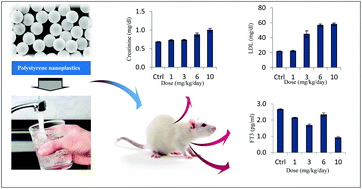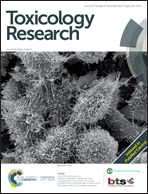Thyroid endocrine status and biochemical stress responses in adult male Wistar rats chronically exposed to pristine polystyrene nanoplastics†
Abstract
Toxicity evaluations of micro- or nano-sized plastics in rodent species commonly employed for toxicity analyses based on which risk assessment for humans could be performed are still largely lacking. Given this knowledge gap, the present work was aimed at determining the potential impact of chronic exposure to polystyrene nanoplastics (PS NPs) on the thyroid endocrine status and biochemical stress in a rat model. Young adult male rats were orally administered with PS NPs (1, 3, 6 and 10 mg kg−1 day−1) for five weeks. Thyroid hormones (THs) L-thyroxine (T4), L-triiodothyronine (T3), L-free triiodothyronine (FT3), and L-free thyroxine (FT4) as well as thyroid stimulating hormone (TSH) serum levels of normal rats and those exposed to PS NPs were compared. Serum levels of high-density lipoprotein (HDL), low-density lipoprotein (LDL), cholesterol, and creatinine, as well as glutamic oxaloacetic transaminase (GOT) and glutamic pyruvic transaminase (GPT) enzymes were also measured. Exposure to PS NPs suppressed the serum levels of T3 and circulating levels of THs, whereas TSH increased significantly. Though exposure to PS NPs did not affect the molar ratios of T3/T4, it induced a slight, but significant, increase in FT3/FT4. In addition, exposure to plastic nanoparticles showed signs of nephrotoxicity induction and kidney injury in exposed organisms as can be inferred from the significantly higher serum levels of creatinine in exposed groups. Our results provide clear evidence of an association between exposure to plastic NPs and thyroid endocrine disruption as well as metabolic deficit, and generate new leads for future research efforts.



 Please wait while we load your content...
Please wait while we load your content...